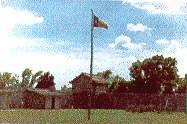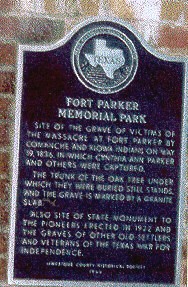

| Jo Ann Flowers | Fall 1998 |
| History 1302 | Hines |
Click on map to see larger view.



 In 1836, the fort fell under
attack by Comanche Indians, five settlers were killed and others were captured.
One captured was the nine-year-old granddaughter of the founder of the
fort, Cynthia Ann Parker. She stayed with the Indians for 29 year
and became the mother of the last great Comanche chief, Quanah Parker.
The rest of her story can be found at the fort. The inside area of
the fort has been built, according to records from the 1800 period.
In 1836, the fort fell under
attack by Comanche Indians, five settlers were killed and others were captured.
One captured was the nine-year-old granddaughter of the founder of the
fort, Cynthia Ann Parker. She stayed with the Indians for 29 year
and became the mother of the last great Comanche chief, Quanah Parker.
The rest of her story can be found at the fort. The inside area of
the fort has been built, according to records from the 1800 period.
Chamber of Commerce. Groesbeck: The Friendly City: Gateway to Lake of Limestone. 1933: Pamphlet.Stanton, Martha. City of Gorebeck. October 1988.
Stanton, Martha. How Groesbeck, Texas, Limestone County, Got it's Name. October 1998
Texas Parks and Wildlife Department. Fort Parker State Recreation Area. 1993: Pamphlet.
Turner, Jerry. How some places in Limestone county were named. Martha Stanton. 1998.